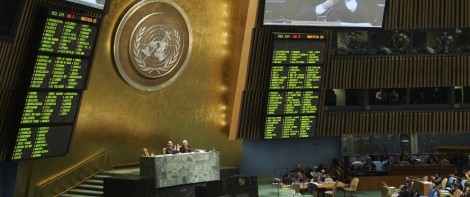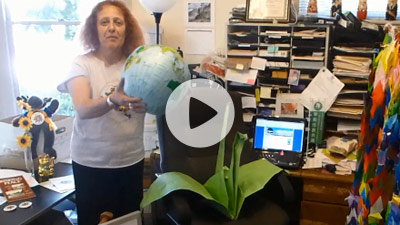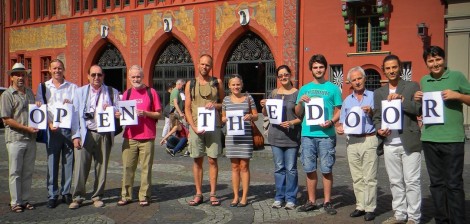Yesterday (4 November 2013) the door to a nuclear weapon free world was opened wider. 151 countries supported the UN Open Ended Working Group resolution. 129 supported the NAM resolution for negotiations on a nuclear weapons convention, a high level nuclear disarmament conference and establishing an International Day for the Total Elimination of Nuclear Weapons
From May to August 2013, the UN Open Ended Working Group ‘opened the door’ to a nuclear weapon free world (see UN body adopts report on advancing nuclear disarmament negotiations). This was followed on 26 September by the first ever UN High Level Meeting on nuclear disarmament.
Yesterday the door was opened wider with the resounding adoption at the United Nations First Committee (Disarmament and International Security) of two key nuclear disarmament resolutions.

Voting boards at the United Nations General Assembly - UN Photo/Devra Berkowitz
Resolution L.6: Follow-up to the 2013 high-level meeting of the General Assembly on nuclear disarmament;
On 26 September this year, the United Nations General Assembly, for the first time ever, held a High Level Meeting dedicated to the total elimination of nuclear weapons. The meeting elevated the issue but did not take any decisions. The next step was taken yesterday with the adoption by the UN General Assembly of a follow-up action resolution. Introduced by the Non-Aligned Movement (NAM), Resolution L.6 calls for the immediate commencement of negotiations in the Conference on Disarmament on a nuclear weapons convention.
Before the negotiations can begin, however, the Conference on Disarmament (CD) will have to overcome its deadlock of 17 years. The CD has established an Informal Working Group to tackle this challenge head on. So there is at last a possibility for progress. The resolution calls on the UN Secretary General to review progress later in the year, with the input of States (all are invited to do so) and report back to the next UN General Assembly in October 2014. In addition the UN General Assembly, in adopting Resolution L.6, decides to:
a. hold a UN High Level Conference on Nuclear Disarmament in 2018 to review and advance the process, and
b. establish 26 September as the International Day for the Total Elimination of Nuclear Weapons.
129 countries voted in favour of the resolution, a significant majority of the UN Members.

Jackie Cabasso in an Open the door video
‘This is an historic resolution,’ says Jackie Cabasso, Director of Western States Legal Foundation (USA) and co-founder of the Abolition 2000 Global Network to Eliminate Nuclear Weapons. ‘It reflects years of persistent and consistent civil society advocacy for the global abolition of nuclear weapons through a nuclear weapons convention. Now we have a definite goal set and a process agreed by United Nations members for its accomplishment. We hope that everyone will get behind this and make it work.’
Resolution L.34 Taking forward multilateral nuclear disarmament negotiations
In 2012, frustrated at the lack of progress in the Conference on Disarmament, the United Nations General Assembly established a new and innovative initiative – an Open Ended Working Group on Taking Forward Multilateral Nuclear Disarmament Negotiations (OEWG). Governments and civil society engaged in constructive, interactive and successful deliberations on elements and approaches to achieving a nuclear weapons free world. The governments adopted a consensus report which includes a range of innovative proposals – including the ‘building blocks’ approach.
A super-majority of UN members (154 countries) voted for Resolution L.34 (see voting sheet) calling on the Conference on Disarmament (and other forums) to take up the nuclear disarmament proposals in the OEWG report. The resolution (like the NAM resolution) calls for a UN Secretary General report and evaluation at the UN General Assembly in October 2014 of how these multilateral nuclear disarmament negotiations are progressing, and whether further work should be undertaken by the OEWG in 2015 in order to ensure sufficient progress is made on multilateral nuclear disarmament negotiations.

Ambassador Dengo, Chair of the Open Ended Working Group, with students in Basel
‘The Open Ended Working Group has opened the door to a nuclear weapon free world,’ says Jana Jedlickova, Coordinator of the Abolition 2000 Task Force on the OEWG. ‘It has brought a constructive approach into nuclear disarmament diplomacy, started to bridge the divides that have until now blocked progress, and identified key areas where further work is required to ensure success. It’s time now for the deliberations and proposals to move on to practical work and actual negotiations for the elimination of nuclear weapons.’
‘Civil society, including mayors and parliamentarians, played a key role in the success to-date of the OEWG,’ says Alyn Ware, Global Coordinator of Parliamentarians for Nuclear Non-proliferation and Disarmament. ‘This included participating fully in the OEWG sessions and promoting the process globally, particularly through inspiring Open the door actions. We should encourage our governments to ensure that the opportunity that has now arisen from the OEWG is not squandered.’

Drawing by Alessio, Pratteln-Basel Secondary School, Switzerland
'Open the Door to a Nuclear Weapons Free World' Project
www.openthedoor2013.org / info@openthedoor2013.org
